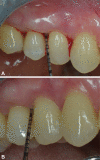Preliminary Evaluation of a NitrAdine-Based Brushing Solution for Patients Suffering from Gingivitis: A Prospective Clinical Case-Control Study
- PMID: 34875712
- PMCID: PMC9507566
- DOI: 10.1055/s-0041-1741120
Preliminary Evaluation of a NitrAdine-Based Brushing Solution for Patients Suffering from Gingivitis: A Prospective Clinical Case-Control Study
Abstract
Objectives: This article aimed to evaluate the clinical efficacy of a nonantibiotic biofilm-removal formulation based on NitrAdine (PerioTabs), combined with a regular home oral hygiene regimen, in Caucasian patients with gingivitis.
Materials and methods: A sample of 60 patients were included in this clinical prospective study. All selected subjects underwent regular prophylaxis and professional oral hygiene at baseline; 30 days later, they were recalled for the measurements of the reference parameters about bleeding on probing (full-mouth bleeding upon probing score [FMBS]) and plaque index (full-mouth plaque score [FMPS]); no other clinical procedure was performed. Consequently, half of the patients (n = 30) were instructed to use PerioTabs for 10 days. The remaining patients (n = 30) were used as the negative control, only instructed to continue with their usual oral hygiene regimen. Fifteen days after, the clinical parameters of FMBS and FMPS were re-evaluated in both groups.
Results: Changes in the scores of clinical indices FMBS and FMPS were calculated and compared. A significant difference between pre- and post-values, for both FMBS and FMPS, was noticed in the test group; in particular, the bleeding index value demonstrated the more significant changes: 22 participants showed a clinically meaningful improvement, and 5 had a small improvement. Only three patients had no evidence of change. In addition, 50% of patients had a reduction in plaque levels. No side effects were reported.
Conclusions: The adjunctive use of 10-day PerioTabs treatment in the daily oral hygiene routine seemed to be efficient in reducing gingival bleeding and plaque accumulation, with absence of adverse effects. These results should be confirmed in studies with a larger number of participants following a controlled-blinded design.
The Author(s). This is an open access article published by Thieme under the terms of the Creative Commons Attribution License, permitting unrestricted use, distribution, and reproduction so long as the original work is properly cited. (https://creativecommons.org/licenses/by/4.0/).
Conflict of interest statement
None declared.
Figures
Similar articles
-
Efficacy of PerioTabs, a NitrAdine-based gingiva brushing solution, on periodontally affected patients treated with fixed partial dentures: a randomized controlled study.Quintessence Int. 2021 Mar 3;52(4):292-298. doi: 10.3290/j.qi.b912689. Quintessence Int. 2021. PMID: 33491389
-
Comparison of irrigation to floss as an adjunct to tooth brushing: effect on bleeding, gingivitis, and supragingival plaque.J Clin Dent. 2005;16(3):71-7. J Clin Dent. 2005. PMID: 16305005 Clinical Trial.
-
The Effectiveness of Individualized Oral Hygiene Education in Preventing Dental Diseases: A Clinical Study.J Clin Med. 2024 Sep 15;13(18):5481. doi: 10.3390/jcm13185481. J Clin Med. 2024. PMID: 39336968 Free PMC article.
-
Routine scale and polish for periodontal health in adults.Cochrane Database Syst Rev. 2018 Dec 27;12(12):CD004625. doi: 10.1002/14651858.CD004625.pub5. Cochrane Database Syst Rev. 2018. PMID: 30590875 Free PMC article.
-
WITHDRAWN: Interdental brushing for the prevention and control of periodontal diseases and dental caries in adults.Cochrane Database Syst Rev. 2019 Apr 24;4(4):CD009857. doi: 10.1002/14651858.CD009857.pub3. Cochrane Database Syst Rev. 2019. PMID: 31017680 Free PMC article. Review.
References
-
- Chapple I LC, Mealey B L, Van Dyke T E. Periodontal health and gingival diseases and conditions on an intact and a reduced periodontium: consensus report of workgroup 1 of the 2017 World Workshop on the Classification of Periodontal and Peri-Implant Diseases and Conditions. J Periodontol. 2018;89 01:S74–S84. - PubMed
-
- Kumar S. Evidence-based update on diagnosis and management of gingivitis and periodontitis. Dent Clin North Am. 2019;63(01):69–81. - PubMed
-
- Cabras M, Gambino A, Broccoletti R, Arduino P G. Desquamative gingivitis: a systematic review of possible treatments. J Biol Regul Homeost Agents. 2019;33(02):637–642. - PubMed
-
- Murakami S, Mealey B L, Mariotti A, Chapple I LC. Dental plaque-induced gingival conditions. J Periodontol. 2018;89 01:S17–S27. - PubMed
-
- Caton J G, Armitage G, Berglundh T. A new classification scheme for periodontal and peri-implant diseases and conditions - introduction and key changes from the 1999 classification. J Periodontol. 2018;89 01:S1–S8. - PubMed
LinkOut - more resources
Full Text Sources


